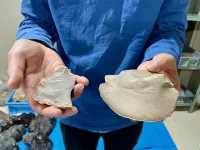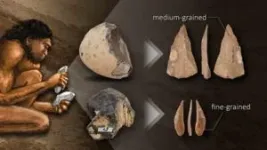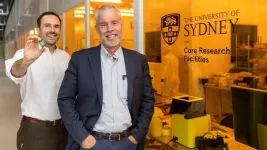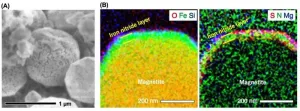(Press-News.org) A research group led by the Nagoya University Museum and Graduate School of Environmental Studies in Japan has clarified differences in the physical characteristics of rocks used by early humans during the Paleolithic. They found that humans selected rock for a variety of reasons and not just because of how easy it was to break off. This suggests that early humans had the technical skill to discern the best rock for the tool. The researchers published the results in the Journal of Paleolithic Archaeology.
As Homo sapiens moved from Africa to Eurasia, they used stone tools made of rocks, such as obsidian and flint, to cut, slice, and craft ranged weapons. Because of the significant role they played in their culture, understanding how early humans made stone tools is important to archaeologists.
Since the geographic expansion of Homo sapiens in Eurasia started in the Middle East, archaeologists Eiki Suga and Seiji Kadowaki from Nagoya University focused on the prehistoric sites belonging to three chronological periods in the Jebel Qalkha area, southern Jordan. The team analyzed flint nodules in the outcrops that were exploited during the Middle and Upper Paleolithic (70,000 to 30,000 years ago).
They believe Paleolithic humans understood which rocks were appropriate for making tools and, therefore, intentionally searched for them. According to their hypothesis, Paleolithic humans intentionally searched for flint that was translucent and smooth, as it could be easily broken off the rock face and shaped into sharp edges.
The group used a Schmidt Hammer and a Rockwell Hardness Device to test the mechanical properties of the rocks. The Schmidt Hammer measures the elastic behavior of a material after the hammer strikes it, which tells researchers its rebound hardness. The Rockwell hardness device presses a diamond indenter on the rock surface to test its strength.
At first, as Suga and Kadowaki expected, fine-grained flint was found to require less force to fracture than medium-grained flint. This would have made the fine-grained flint more attractive in producing small stone tools. Indeed, many stone tools from the Early Upper Paleolithic (40,000 to 30,000 years ago) contain fine-grained flint.
However, an earlier study by the same team found that during the Late Middle Paleolithic and the Initial Upper Paleolithic (70,000 to 40,000 years ago), medium-grained flint was more commonly used in stone tools than fine-grained flint. But if fine-grained flint was so easy to use, why did our ancestors not make all their tools from it?
On further investigation, the researchers found that much of the fine-grained flint in the area suffered from abundant internal fractures caused by geological activities, which would have made it unsuitable for large stone tools, such as Levallois products and robust blades. Therefore, it seems that Paleolithic humans selected the medium-grained flint for large tools, even though it was a tough material to modify into tools, as it was more likely to last longer. This offers a fascinating insight into our ancestors’ behavior, as they selected flint based on many factors other than just how easy it was to fracture and could discern the most suitable rock to use to make stone tools.
Suga is enthusiastic about the findings, which suggest the complexity of our ancestors' behaviour. “This study illustrates that the Paleolithic humans changed their choice of raw material to suit their stone tool morphologies and production techniques,” he said. “We believe that these prehistoric humans had a sensory understanding of the characteristics of the rocks and intentionally selected the stone material to be used according to the form and production technique of the desired stone tools. This intentional selection of the lithic raw material may have been an important component of the production of stone tools. This may show some aspect of flexible technological behavior adapted to the situation.”
“There are still many unanswered questions about why extant humans expanded their distribution 50,000 to 40,000 years ago. Recently, ancient DNA analysis showed that modern humans (Homo sapiens) interacted and interbred with Neandertals and Denisovans. However, ancient DNA cannot tell us about the actual historical events and how they occurred,” Suga said. “If we want to know what happened that allowed Homo sapiens to thrive, we need to study cultural remains, such as stone tools, excavated from archaeological sites. This kind of resource use is an important record for elucidating the evolution of human technological behavior, environmental adaptation, and the process of population growth at that time.”
END
Paleolithic humans may have understood the properties of rocks for making stone tools
2023-12-01
ELSE PRESS RELEASES FROM THIS DATE:
A patch of protection against Zika virus
2023-12-01
A simple-to-apply, needle-free vaccine patch is being developed to protect people from the potentially deadly mosquito-borne Zika virus.
A prototype using The University of Queensland-developed and Vaxxas-commercialised high-density microarray patch (HD-MAP) has delivered a University of Adelaide-developed vaccine and elicited an effective immune response to Zika virus in mice.
UQ alum and Vaxxas researcher Dr Danushka Wijesundara said Zika virus was a risk to people across the Pacific, Southeast Asia, India, Africa and South and Central America.
“We can change the way we combat Zika virus with the ...
ORNL supports executive order for safe, secure and trustworthy AI
2023-12-01
As artificial intelligence technologies improve, they increase the efficiency and capabilities of research across the scientific spectrum. Because of the rapid pace of the field, AI tools must be developed sustainably, a guiding principle for the Department of Energy’s Oak Ridge National Laboratory throughout its 40 years of AI research. Now, its extensive array of resources are supporting the nation as it harnesses the power of these transformative technologies.
In October, President Biden ...
Photonic chip that ‘fits together like Lego’ opens door to semiconductor industry
2023-12-01
Researchers at the University of Sydney Nano Institute have invented a compact silicon semiconductor chip that integrates electronics with photonic, or light, components. The new technology significantly expands radio-frequency (RF) bandwidth and the ability to accurately control information flowing through the unit.
Expanded bandwidth means more information can flow through the chip and the inclusion of photonics allows for advanced filter controls, creating a versatile new semiconductor device.
Researchers expect the chip will have application in advanced radar, ...
Meteorites likely source of nitrogen for early Earth
2023-12-01
Micrometeorites originating from icy celestial bodies in the outer Solar System may be responsible for transporting nitrogen to the near-Earth region in the early days of our solar system. That discovery was published today in Nature Astronomy by an international team of researchers, including University of Hawai'i at Mānoa scientists, led by Kyoto University.
Nitrogen compounds, such as ammonium salts, are abundant in material born in regions far from the sun, but evidence of their transport to Earth's orbital region had been poorly understood.
"Our recent findings suggests the possibility that a greater amount of nitrogen compounds than previously ...
Can artificial intelligence improve life science? As much as life science can improve AI, researchers say
2023-12-01
Artificial intelligence (AI) may attempt to mimic the human brain, but it has yet to fully grasp the complexity of what it means to be human. While it may not truly understand feelings or original creativity, it can help us better understand ourselves — especially our physical bodies in health and in disease, according to a series of articles recently published by the journal Quantitative Biology.
The peer-reviewed papers — a variety of editorials, perspectives and commentaries on AI for life science — assess the rapid development of AI and recent attention ...
CureSHANK seeking RFAs to stimulate research of SHANK3-related epilepsy in Phelan-McDermid syndrome
2023-12-01
CureSHANK will award a total of $250,000 aimed at stimulating research on SHANK3-related epilepsy, prevalent in PMS patients. The grants, CureSHANK Research to Cure Grant: Epilepsy (R2C Epilepsy), will provide targeted funding to support SHANK3-related epilepsy research projects. The awards aim to improve mechanistic and clinical knowledge of SHANK3-related epilepsy.
The PMS community lives under the long shadow of epilepsy: it is responsible for many deaths of both children and young adults with PMS, and it is among the disorder's most distressing symptoms. Nearly one-third of individuals living with PMS are diagnosed with epilepsy, often evolving ...
Eating beans improves gut health, regulates immune and inflammatory processes in colorectal cancer survivors
2023-12-01
HOUSTON ― Incorporating navy beans into the diet of colorectal cancer (CRC) survivors has the potential to positively impact both gut and host health by modulating markers linked to obesity and disease, according to new research from The University of Texas MD Anderson Cancer Center.
The findings published today in eBIOMedicine, part of The Lancet family of journals, revealed BE GONE trial participants who added a cup of navy beans daily to their regular meals saw positive changes in their gut microbiome, which is associated with cancer prevention and improved treatment outcomes. Changes included an increase ...
One of the largest magnetic storms in history quantified: Aurorae covered much of the night sky from the Tropics to the Polar Regions
2023-12-01
In early November of this year, aurora borealis were observed at surprisingly low latitudes, as far south as Italy and Texas. Such phenomena indicate the impacts of a solar coronal mass ejection on the Earth's magnetic field and atmosphere. Far more dramatic than this recent light show was, it was nothing compared to a huge solar storm in February 872. The resulting auroral display from that event ringed the globe and produced auroras observed in sites as close to the equator as Bombay and Khartoum. An international team consisting of scientists from nine counties has now published a detailed study of this historically important event, tracing its ...
Consensus needed on when global warming reaches 1.5°C
2023-12-01
Writing in the journal Nature ahead of COP28, a team of Met Office scientists has emphasised that – surprisingly – there is currently no formally agreed way of defining the current level of global warming relevant to the Paris Agreement.
They have proposed a solution.
While the global average temperature in a particular year is well-known, this will not be suitable as an indicator of whether the “Paris 1.5” has been breached or not, because the Paris Agreement refers to long-term warming, not individual years.
But no alternative has yet been formally agreed.
Without ...
Study identifies barriers that limit young men at HIV risk from taking preventative drug
2023-12-01
Results of a qualitative research study into the uptake of PrEP - a drug which stops HIV infecting the body - suggests that more needs to be done to breakdown barriers to access for the potentially lifesaving medication.
Research published in the Journal of Prevention and Health Promotion from a team at the University of Bath finds that knowledge and awareness among young men who have sex with other men about the drug is low and there is often stigma associated with being prescribed PrEP.
Pre-exposure prophylaxis ‘PrEP’ refers to a pill that prevents HIV contraction in HIV-negative individuals. PrEP ...








